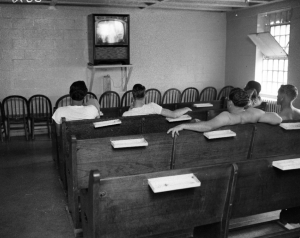Useful Media
As breakthroughs in digital technologies compel scholars to address media consumption outside the traditional contexts of the theater and the home, media historians remind us that audio/visual materials have always proliferated in other places: city halls, churches, courtrooms, classrooms, hospitals, union halls, corporate offices, factories, and laboratories. Within such alternative venues, media function as tools of education, justice, agitation, advocacy, professionalization, strategy, training, and proselytizing. These frequently overlooked uses of media, beyond art and entertainment, remind us that the patterns of production, distribution, and consumption commonly invoked by terms like “the movies” or “television” represent only certain configurations within the broader field of media practice.
Recent developments in the accessibility of educational and industrial media—through the Internet Archive, YouTube postings of leaked training videos, and DVD anthology collections (e.g., Treasures from American Film Archives)—have brought these other media venues and practices to a new prominence. Likewise, an increase in scholarly attention paid to “useful” media, as in the recent anthologies Useful Cinema (Acland and Wasson, 2011) and Learning with the Lights Off (Orgeron, Orgeron, and Streible 2012), encourages us to revise our assumptions about how media function in everyday life and rethink the very definitions of media forms that scholars often take for granted.
Exploring the incredible diversity of media production and practice across these many contexts opens up a wide field of possible study. Attending to how media has long been used by religious institutions, civic organizations, NGOs, unions, libraries, governments, and prisons might mean investigating alternative modes of reception, compulsory viewing, and resistant readings. It could also mean a turn to how various modes of ideology, style, and representation serve institutional ends. Studies interested in media within the academy might explore how audiovisual and applied media are employed in scientific and social scientific research or how media policy shapes the production and distribution of educational media. Historical analyses could investigate how film, video, and sound recordings found their way into the factory and museum tours and why ambient music has infiltrated public and semi-public spaces (malls, factories, restaurants, waiting rooms). Likewise, production cultures of industrial media and the histories of key practitioners and production houses provide robust topics for media industries research. The list of additional possible avenues of research is expansive, ranging from training videos, sponsored film, and institutional uses of podcasts to the intersections between institutional media, architectural design, and spatial politics.
These are the issues the editors of The Velvet Light Trap are interested in exploring in its latest issue. If you are also interested in the production, distribution, exhibition, and/or reception of educational, industrial, and other institutional film, video, television, audio, and new media, past and present, we encourage you to submit a paper. We are accepting anonymous electronic submissions between 6,000 and 7,500 words in Chicago style until September 15, 2012. To submit a paper or to learn more, send an email to thevelvetlighttrap@gmail.com.



